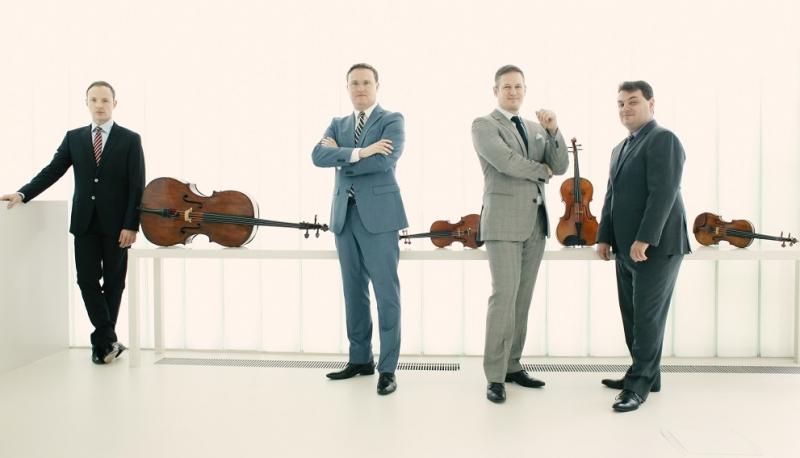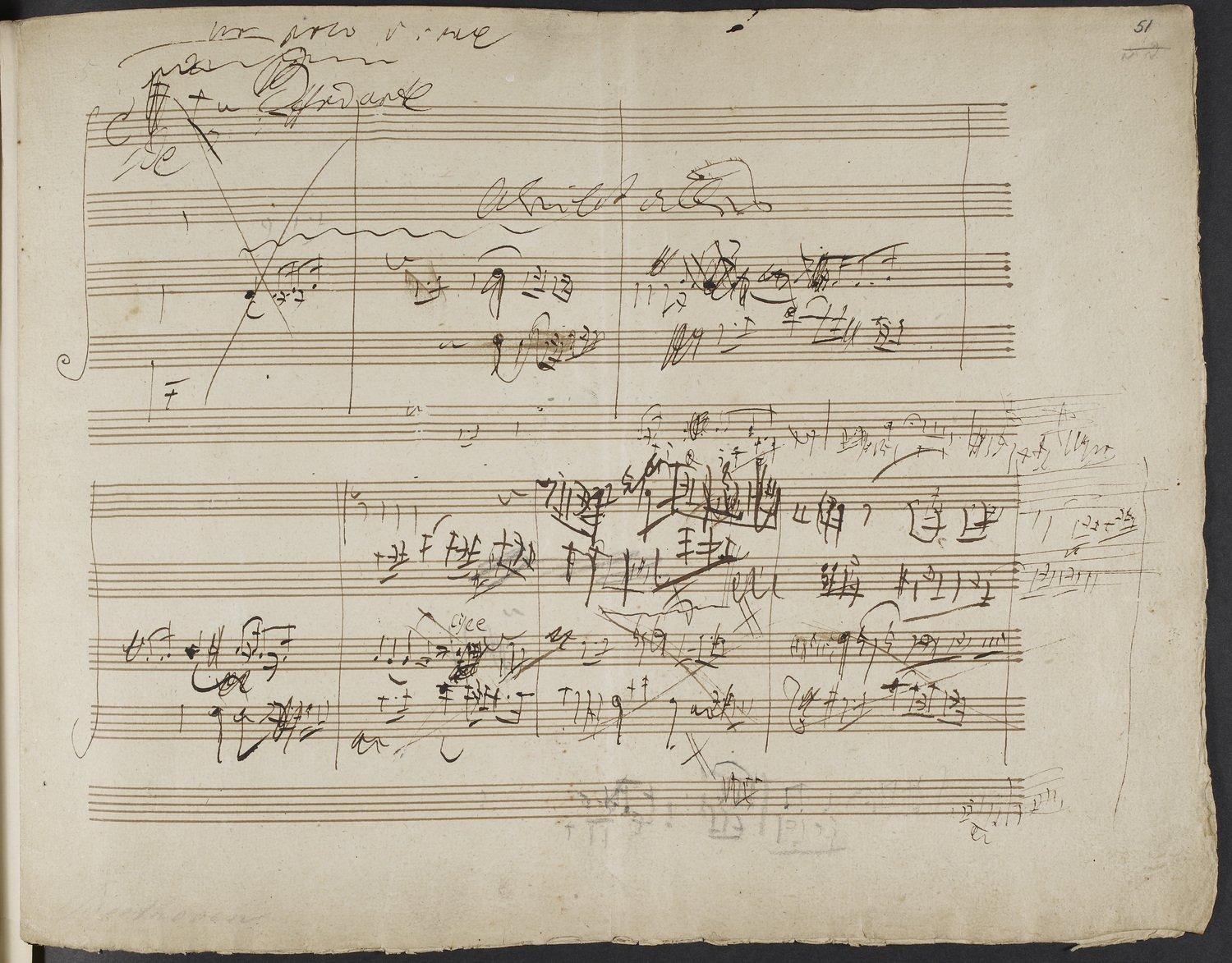Jerusalem Quartet, Wigmore Hall review - shock and sophistication in ideally-proportioned Beethoven | reviews, news & interviews
Jerusalem Quartet, Wigmore Hall review - shock and sophistication in ideally-proportioned Beethoven
Jerusalem Quartet, Wigmore Hall review - shock and sophistication in ideally-proportioned Beethoven
Early, middle and late masterpieces in revelatory performances

Three Beethoven quartets, early, middle and late, in a single evening – inevitably as part of a cycle, like the Jerusalems’ Wigmore Hall triptych last night – is demanding on the audience, supremely tough on the players.
We could have left this concert enriched and on a high at the half-way mark, open-mouthed at the brilliance of the tumultuous fugal finale in the third “Razumovsky” Quartet, Op. 59 No. 3 in C. Never was an interval needed more before the four players returned to the awesome challenge of the great, seven-movement C shap minor Quartet Op. 131 (one of Beethoven's sketches pictured below): exhausting for all concerned, but riveting in every bar.
Never underestimate the challenges of what for me is the most memorable quartet in the Op.18 set of six, No. 3 in D. The Jerusalems took us from the supremely elegant opening gambit of Alexander Pavlovsky to cellist Kyril Zlotnikov’s rocking of the foundations before the witty-soft conclusion. Zlotnikov seems to urge the most creative responses, making us inwardly exclaim another “what on earth?” in the swelling resonance of the stalking 6/8 pizzicati of the C major Quartet’s mysterious slow-movement ballad. But that’s not to suggest any unevenness among the four; and their takes, though very much adapted to the special demands of each quartet, always kept a balance between shock and sophistication: ideal Beethoven, in other words.  Go to any music festival and you’ll probably encounter yet another of the many hundreds, if not thousands, of fine string quartets in the world. Setting the Jerusalems in the top half-dozen are the unstinting focus of articulation, the subtle freedoms, above all the dynamic nuancing: how that in particular was possible at the daunting speed they set themselves in the joyous fugal finale of the third “Razumovsky” – here Vivacissimo rather than just Allegro molto – gave us one of the reasons for breathless enthusiasm at interval time.
Go to any music festival and you’ll probably encounter yet another of the many hundreds, if not thousands, of fine string quartets in the world. Setting the Jerusalems in the top half-dozen are the unstinting focus of articulation, the subtle freedoms, above all the dynamic nuancing: how that in particular was possible at the daunting speed they set themselves in the joyous fugal finale of the third “Razumovsky” – here Vivacissimo rather than just Allegro molto – gave us one of the reasons for breathless enthusiasm at interval time.
The flipside came at the start of the C sharp minor Quartet after we’d taken 20 minutes to gather composure: the contrasting slow fugue of the opening Adagio ma non troppo e molto espressivo. Only fleetingly was this as Wagner described it, “the saddest thing ever said in notes”; after the unearthly voices of first and second violins, there is a warming to life, even radiance which makes the heaven’s-gate sequence of inner movements possible. I still can’t say I understand what Beethoven was up to here, but with such a great team compelling the listener’s focus on every phrase, every sudden oddity, it was impossible to lose concentration. How they held out to the galloping rigour of the intense finale was a miracle; the sense of near-exhaustion merely added to the thrill.
No doubt about it: great works in great performances. We felt, as ever, the connection to the pathos and horror of the present time without the need for anyone to spell it out. Though Israeli citizens, violinists Pavlovsky and Sergei Bresler were born in Ukraine, Zlotnikov in Belarus. I now wish I hadn’t missed the first two concerts in the series; I’ll be there, if I can, for the two in June.
- Next concerts in the Jerusalem Quartet's Beethoven cycle on Friday 10 June and Saturday 11 June
- More classical music reviews on theartsdesk
rating
Share this article
The future of Arts Journalism
You can stop theartsdesk.com closing!
We urgently need financing to survive. Our fundraising drive has thus far raised £49,000 but we need to reach £100,000 or we will be forced to close. Please contribute here: https://gofund.me/c3f6033d
And if you can forward this information to anyone who might assist, we’d be grateful.

Subscribe to theartsdesk.com
Thank you for continuing to read our work on theartsdesk.com. For unlimited access to every article in its entirety, including our archive of more than 15,000 pieces, we're asking for £5 per month or £40 per year. We feel it's a very good deal, and hope you do too.
To take a subscription now simply click here.
And if you're looking for that extra gift for a friend or family member, why not treat them to a theartsdesk.com gift subscription?
more Classical music
 Robin Holloway: Music's Odyssey review - lessons in composition
Broad and idiosyncratic survey of classical music is insightful but slightly indigestible
Robin Holloway: Music's Odyssey review - lessons in composition
Broad and idiosyncratic survey of classical music is insightful but slightly indigestible
 Classical CDs: Wolf-pelts, clowns and social realism
British ballet scores, 19th century cello works and contemporary piano etudes
Classical CDs: Wolf-pelts, clowns and social realism
British ballet scores, 19th century cello works and contemporary piano etudes
 Bizet in 150th anniversary year: rich and rare French offerings from Palazzetto Bru Zane
Specialists in French romantic music unveil a treasure trove both live and on disc
Bizet in 150th anniversary year: rich and rare French offerings from Palazzetto Bru Zane
Specialists in French romantic music unveil a treasure trove both live and on disc
 Scottish Chamber Orchestra, Ibragimova, Queen’s Hall, Edinburgh review - rarities, novelties and drumrolls
A pity the SCO didn't pick a better showcase for a shining guest artist
Scottish Chamber Orchestra, Ibragimova, Queen’s Hall, Edinburgh review - rarities, novelties and drumrolls
A pity the SCO didn't pick a better showcase for a shining guest artist
 Kilsby, Parkes, Sinfonia of London, Wilson, Barbican review - string things zing and sing in expert hands
British masterpieces for strings plus other-worldly tenor and horn - and a muscular rarity
Kilsby, Parkes, Sinfonia of London, Wilson, Barbican review - string things zing and sing in expert hands
British masterpieces for strings plus other-worldly tenor and horn - and a muscular rarity
 From Historical to Hip-Hop, Classically Black Music Festival, Kings Place review - a cluster of impressive stars for the future
From quasi-Mozartian elegance to the gritty humour of a kitchen inspection
From Historical to Hip-Hop, Classically Black Music Festival, Kings Place review - a cluster of impressive stars for the future
From quasi-Mozartian elegance to the gritty humour of a kitchen inspection
 Shibe, LSO, Adès, Barbican review - gaudy and glorious new music alongside serene Sibelius
Adès’s passion makes persuasive case for the music he loves, both new and old
Shibe, LSO, Adès, Barbican review - gaudy and glorious new music alongside serene Sibelius
Adès’s passion makes persuasive case for the music he loves, both new and old
 Anja Mittermüller, Richard Fu, Wigmore Hall review - a glorious hall debut
The Austrian mezzo shines - at the age of 22
Anja Mittermüller, Richard Fu, Wigmore Hall review - a glorious hall debut
The Austrian mezzo shines - at the age of 22
 First Person: clarinettist Oliver Pashley on the new horizons of The Hermes Experiment's latest album
Compositions by members of this unusual quartet feature for the first time
First Person: clarinettist Oliver Pashley on the new horizons of The Hermes Experiment's latest album
Compositions by members of this unusual quartet feature for the first time
 Gesualdo Passione, Les Arts Florissants, Amala Dior Company, Barbican review - inspired collaboration excavates the music's humanity
At times it was like watching an anarchic religious procession
Gesualdo Passione, Les Arts Florissants, Amala Dior Company, Barbican review - inspired collaboration excavates the music's humanity
At times it was like watching an anarchic religious procession
 Classical CDs: Camels, concrete and cabaret
An influential American composer's 90th birthday box, plus British piano concertos and a father-and-son duo
Classical CDs: Camels, concrete and cabaret
An influential American composer's 90th birthday box, plus British piano concertos and a father-and-son duo
 Cockerham, Manchester Camerata, Sheen, Martin Harris Centre, Manchester review - re-enacting the dawn of modernism
Two UK premieres added to three miniatures from a seminal event of January 1914
Cockerham, Manchester Camerata, Sheen, Martin Harris Centre, Manchester review - re-enacting the dawn of modernism
Two UK premieres added to three miniatures from a seminal event of January 1914

Add comment